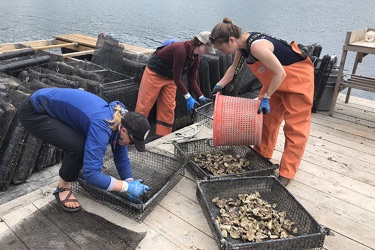Ocean acidification may fundamentally alter oyster farm operations
Courtesy of NOAA Fisheries
While ocean acidification directly affects all oysters, juvenile oysters may struggle the most in an increasingly acidic environment.
Marin County’s connection to oyster production is profound. Up until Drake Bay Oyster Company’s closure in 2014, Marin County-grown oysters accounted for 40 percent of the entire state of California’s oyster production. However, with a global temperature rise and increasingly acidic oceans, local oyster farmers have begun to rethink how they manage their businesses.
Since 1880, global temperatures have risen by approximately two degrees Fahrenheit, driven mostly by carbon-related emissions. While this slight temperature change may seem insignificant, Archie Williams physics and chemistry teacher Barton Clark says temperature changes derived by increased carbon production may alter aquatic ecosystems.
According to Clark, oceans, due in part to their molecular composition, have the unique ability to absorb a multitude of different gasses, including carbon dioxide. When carbon dioxide dissolves in water, it creates carbonic acid, an acidic substance. As humans emit greater concentrations of carbon dioxide into the atmosphere, the ocean will absorb much of the excess, which in turn leads to carbonic acid, contributing to more acidic ocean water.
“Half of the [carbon dioxide] we’re emitting is being pulled into the ocean because there’s this thing in chemistry where water naturally absorbs gasses, so we have gasses dissolve in the water,” Clark said.
Clark says that, like many calcifying organisms, oysters depend on non-acidic ocean water for their survival. If their ambient surroundings become too acidic, oysters will not survive.

According to Clark, oyster shells are made of a compound called calcium carbonate, a chalk-like substance that forms a weak chemical bond. Once calcium carbonate becomes exposed to an acidic substance such as carbon dioxide, its bonds disassociate, leading to the dissolution of the oyster’s protective shell. This makes the oyster vulnerable to predators, such as crab and starfish, and may make them more susceptible to disease in a captive farm.
However, in a cruel twist, the dissolved calcium carbonate creates carbonic acid upon bonding with carbon dioxide, further contributing to ocean acidification.
“One more of these vicious feedback loops is as the oceans become more acidic because of too much carbon dioxide, they start to dissolve things made of calcium carbonate, which then releases more carbon dioxide, which then makes the ocean more acidic, which then dissolves more calcium carbonate,” Clark said.
To ensure ocean water acidity is conducive to oyster breeding, oyster farms routinely monitor the pH levels of the ocean water where they grow their oysters. In essence, pH measures the overall acidity of a substance or liquid, measured on a scale from zero to 14. The lower the pH, the more acidic a substance or liquid is.
Gary Fleener oversees scientific research for Hog Island Oyster Co., an oyster production company and bar in Tomales Bay. He has noticed that ocean acidification has a greater impact on juvenile oysters, whose shells often are not fully developed.
“Oysters and all calcifying organisms depend on a very reliable pH and other associated chemical parameters. With more [carbon dioxide] mixing into the ocean, pH goes down and calcifying organisms like oysters can struggle to build their shells,” Fleener said, “Right now it is not a big issue with adult oysters, but [ocean acidification] can impact juveniles.”
In an effort to mitigate mass oyster mortalities, Fleener says Hog Island Oyster Co. works with shellfish geneticists and breeders to identify types of oysters that may be more resistant to acidification. Additionally, the company continuously measures the pH levels of the water they expose their oysters to.
Due to ocean acidification, oyster farms have begun adapting to a changing climate.
Your donation will support the student journalists of Archie Williams High School. Your contribution will allow us to purchase equipment and cover our annual website hosting costs. Each donation will receive a magazine subscription for a year (6 copies a year), and become a part of the important work our publication is doing.
$35 -- Subscription to the magazine
$50 -- Silver Sponsorship
$75 -- Gold Sponsorship
$100 -- Platinum Sponsorship

Henry is a senior in high school, who loves to play tennis and enjoys spending time outdoors hiking.












